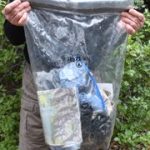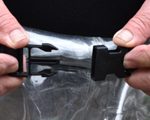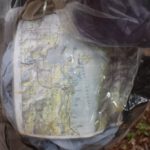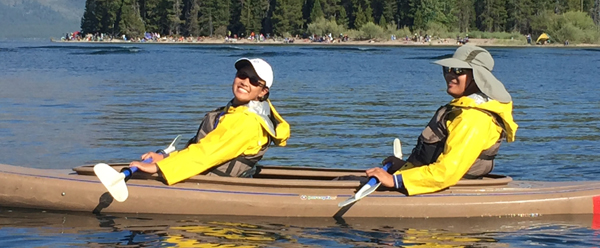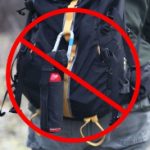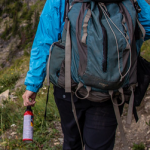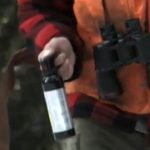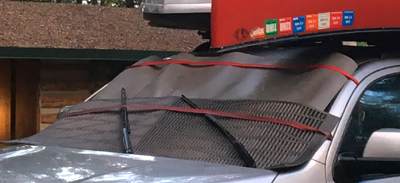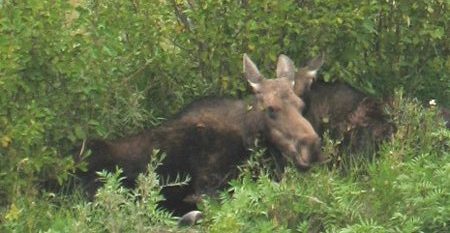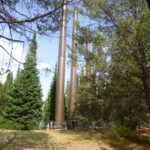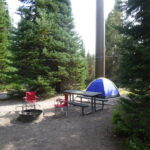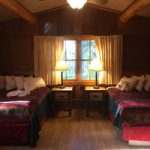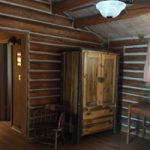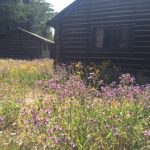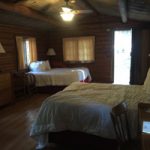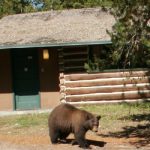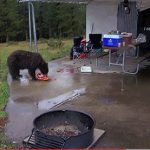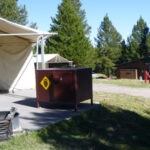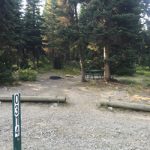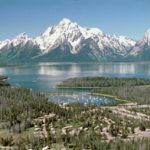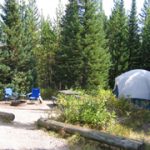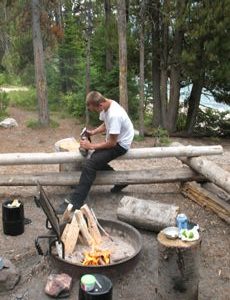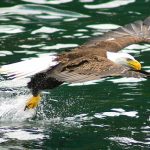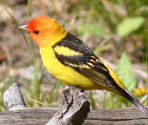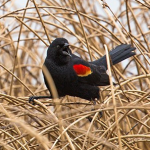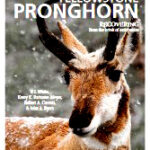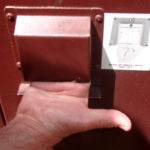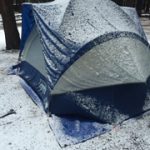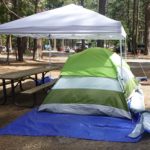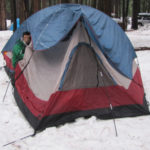This page has links to equipment checklists
(as well as links to details about the Colter Bay cabins the De Anza College Outdoor Club usually stays at)
on Grand Teton National Park kayaking trips.
Photo below by Fred Hanselmann http://www.hanselmannphotography.com/Pictures_of_the_tetons.html)
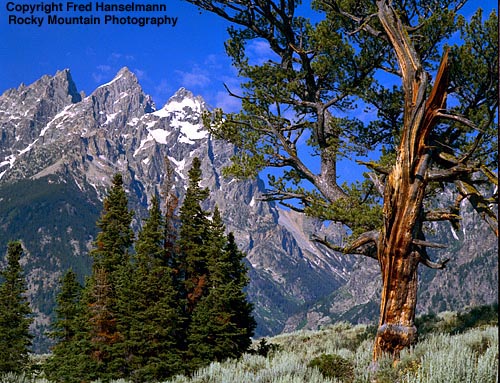
Photo below courtesy of Rick Konrad http://rickkonrad.com/
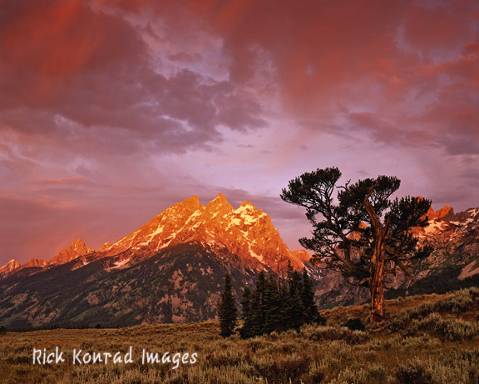
The club will provide: drybags, kayaks, paddles, and lifejackets, (which must be worn and strapped securely) and will transport the De Anza owned kayaks and a canoe.
How to use a dry bag when out kayaking
Before the trip, trip participants will need to try on lifejackets and decide which size / style we will pack for them.
Don’t buy bear spray before the trip, the cost is included in the trip cost you pay the club. No one on our trips has ever had to use (spray) bear spray, but as a safety precaution, everyone carries a can.
Before the trip we usually have people put on their fully-loaded-for-a-long-hike large day pack / backpack, and put a can of bear spray either in a outside pocket or on a harness, and decide which kind they will want to carry.

Bear spray should be in easy reach, not hanging from the back side of your large daypack or backpack,
but it does not need to be out and hand carried.
In a park Back Country Travel video there was a section on bear spray with this:
that shows a can of bear spray tucked in the waistband of a backpack.
But we advise people to consider that if they forget it is there
and take their pack off quickly,
for example to get at their camera for that great picture,
the can could fall to the ground and even roll down a cliff side.
A can in a harness would be immediately accessible and more secure.
Please watch this video provided by Yellowstone park:
![]()
Do not spend money on Grand Teton topographical (hiking) maps until you see the ones the club has for trip participants.
Trip participants are responsible for all other arrangements and costs, including, but not limited to: food, park entrance fees, campsite, cabin or hotel cost, gas and other transportation costs, sleeping and eating gear and other personal gear or the multitude of optional extra pay-for-activities there are in the park and surrounding area.
GEAR TO BRING:
Bring the same stuff you’ll need for the Yosemite winter trip – and might want for early mornings on fall, spring or even summer trips. There will be many sunny days,
but IT WILL RAIN ON THIS TRIP. If you do not have a hooded waterproof rain jacket big enough for a sweater, fleece and/or down vest underneath and waterproof rain pants to go over pants that have room for (non-cotton) polypro long johns underneath, you will not kayak, even in (temporarily) sunny weather. And you should always carry the raingear with you on all hikes. You can get a set of rain pants/jacket at a hardware store then Improve your inexpensive rain gear.
Your gear list should include food and food preparation equipment, tents, sleeping bag, at least two insulating sleeping pads. Be adaptable. Even if you are certain you will onlt stay in a cabin and will not camp, bring tent, sleeping bag and insulated sleeping pads so you can if the opportunity or need arrives. Most years someone will get a backcountry permit and will want companions, since we never hike alone. See: backpacking in Grand Teton National park.
For fall or early morning summer kayaking we wear polypro longjohns, shorts over those and/or fleece on top, and bring rain gear, or on the 2000 fall trip one guy wore his wetsuit with a knit hat. It could be wise to also have a knit hat, mittens, gloves to put on if you feel cold and a swimcap for potentially under the knit hat while kayaking. Expect things to get a little damp or even a little wet, so if at all possible pack a second and third set of long johns and fleece for wearing while not kayaking, including hikes, evening picnics and sleeping.
NO COTTON in the longjohns! You can find lists of gear to bring for winter camping that have things that absolutely apply to this trip at Snow or rain camp must-haves . If you don’t have gear for or have never been rainy/cold camping we really recommend you read this list.
We watch the weather reports closely and try to track thunderstorms as they approach us. One day heavy rain and / or potentially large-sized hail, the size that can crack a windshield, was forecast, so we put two sleeping pads on the windshield under the wipers with a couple of straps tied across and through the shut car doors (the wind was coming up fast as we installed this.)
The hail did not materialize.
And bring your swimsuit, we often end days with long hikes / paddles at the swimming pool
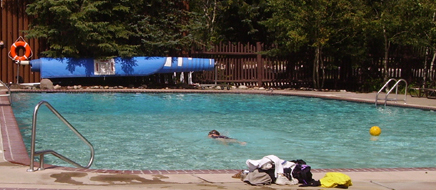
swimming or even playing waterpolo, then taking showers at the pool showers. (Especially good to take showers at the pool if you are trying to cram 8 people in a two-bedroom cabin with only one bathroom shower.)
Triathletes in ocean and lake swims sometimes wear two swim caps at once for extra warmth.
For swimming in the lakes, to be much warmer, a swim cap and “rash guard” shirt is advised.
(And if you have one, you might want to bring a spring wetsuit or wetsuit vest for possible cold / cold-ish water lake swimming unless you are intrepid.)
If you decide to try white-water rafting, you could be much happier with a swim cap for warmth, in case the rafting guide offers the opportunity, at a calm water section of the river, to hop out of the raft and swim a little. Or if the white water rafting guide really aims for the larger waves and the waves splash up into the raft to your waist level or higher. Even better, bring (wear) a vinyl or lycra swim cap right on top of your head, with a fabric one over it – layered for more warmth.
Glacier National Park said about biking in cold / rain
“Windbreakers or rain shells over thin insulated jackets are good layers to bring for possible inclement weather conditions.
A thin, neoprene hat will help keep your head warm, and it will fit under a helmet.
Gloves and neck gaiters assist greatly with retaining warmth.
Bring additional dry and warm layers for after your ride.”
Neoprene is a close-cell synthetic-rubber material that is commonly used in wetsuits and to make an extra thick swim cap an open-water triathlete might wear: closed-cell 3 millimeters thick. Look for a flexible chin strap or you can buy one without a chin strap.
It should fit comfortably under your bike helmet (and climbing helmet) and not interfere with the proper fit of your helmet or your peripheral vision. and – you can use the neoprene hat for swimming and biking.
For noisy campground neighbors or cabin mates who want to stay up later than you, you will wish you had good ear plugs. Most kinds of foam earplugs do not work well. Wax types, often made with silicon putty, are usually better.

To watch the Perseid meteor showers and for stargazing in general, a chair you can lean back in will be most comfortable, but you can also use your sleeping pads and just lie on them on the ground.
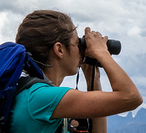 The club advisor brings a few pairs of waterproof binoculars, we can even use while out kayaking, (just be sure to attach the custom-sewn band of floats made from pool lane lines so the binoculars won’t sink if you drop them overboard) but she does not have enough for everyone on a big trip so people will need to share.
The club advisor brings a few pairs of waterproof binoculars, we can even use while out kayaking, (just be sure to attach the custom-sewn band of floats made from pool lane lines so the binoculars won’t sink if you drop them overboard) but she does not have enough for everyone on a big trip so people will need to share.
below, the binoculars with the flotation clipped on, and not clipped on:

You will really want your own binoculars.
and a telephoto lens / tripod for your camera.
You can stay far enough away from animals if you have a telephoto,
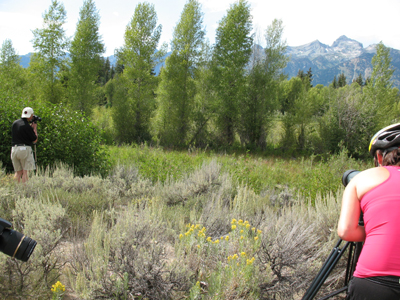
and get a photo of animals other people won’t even be able to see:
We encourage people to bring any and all kinds of telescopes for stargazing.
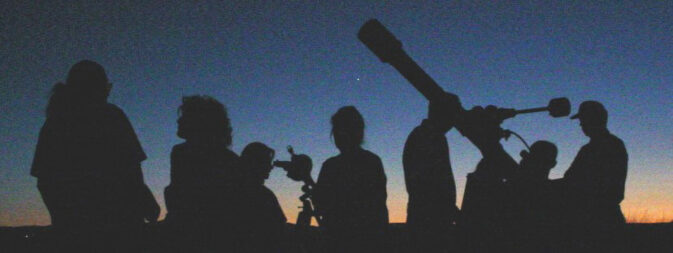
Please also consult the Camping equipment checklist even if you intend to stay in a cabin or hotel. The day hike list and kayaking list at that page have lots of details.
It includes this:
_____ rubber sandals, (NOT FLIP FLOPS) the kind that Velcro around your ankle to stay on your feet (if you don’t want cut feet when out wading/swimming in the lakes and you want to wear them in any public shower such as the shower at the Jackson Lake Lodge pool, or even in the shower in a cabin you share)
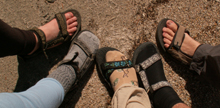
_____ hat (with a brim for low angle morning sun when out kayaking, for example)
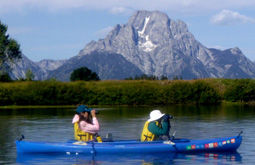
____ at least a large daypack, but a full sized backpack holds more
If you fly to a trip destination, for carry on bags, one airline quoted “Baggage may not exceed 45 linear inches (or 114 cm) in combined length, width and height, including any handles and wheels . . . Baggage must meet carry on size limits (approximately 22″ x 14″ x 9″ or 56 x 35 x 23 cm).”
Consider whether you want to make your really great large day pack for our hikes your carry-on instead of a small suitcase . . .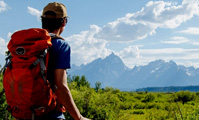
. . . if you fly, wear your hiking boots on the flight to save on weight in your luggage AND to be sure your well-broken in, comfy boots actually get to your adventure. When you get there and your luggage has been delayed or lost, buying new boots and trying to get them broken in enough for (optionlal) longer hikes would be a mistake.
More logistics of packing for flying to the Tetons are at Grand Tetons trip transportation.
Photo below by David Whitten http://www.davidwhittenphoto.com/index.html?yellowteton.html~home
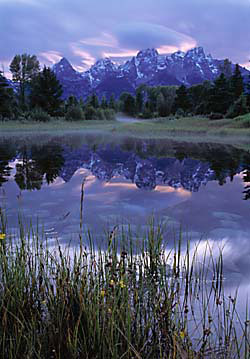
Backpacking Advice has food ideas for a potential wilderness overnight.
During any long hike or backpack,
To truly be able to leave no trace and follow backcountry rules about camping the proper distance from a lake or digging your personal latrine hole the proper distance from water, etc.,
you will need to know how far 100 or 200 feet is.
Lay out a tape measure at home and walk it and count your paces.
How to poop in the woods.
You really will be happier with a comfortable full-sized backpack that fits all your gear, instead of a tiny daypack, for any long hikes.
– – – – – – – – – – – – – – – – – – – – – – – – – – – – – – – – – – – – – – – – – –
You can rent bikes in the park, but bringing your own on a vehicle is cheaper. Bike helmets are required for all ages of riders on all club trips, even if bike riding is not an official part of the trip. Biking in the park can be safe, but due to the large, unpredictable wild animals, there are safety precautions that are different than at home, please read: Grand Tetons biking.
For warmth, look for a thin warm beanie / thin knit cap / maybe a cloth swim cap, that fits comfortably under your bike (and/or climbing) helmet and does not interfere with the proper fit of your helmet or interfere with your peripheral vision.
– – – – – – – – – – – – – – – – – – – – – – – – – – – – – – – – – – – – – – – – – –
 You will need a Wyoming fishing license to fish in Grand Teton National Park, which you can get at various vendors in the park and at the Visitor Center in Jackson. One-day licenses cost much less than annual, so you might want to get more than one one-day license. https://www.nps.gov/grte/planyourvisit/fish.htm
You will need a Wyoming fishing license to fish in Grand Teton National Park, which you can get at various vendors in the park and at the Visitor Center in Jackson. One-day licenses cost much less than annual, so you might want to get more than one one-day license. https://www.nps.gov/grte/planyourvisit/fish.htm
(One place recommends: “Dry Flies: Royal Wulff #10-16, Parachute Adams #10-20, Humpies #14-16, Elk Hair Caddis #14-18, Turck Tarantulas #8-12, Parahoppers #10-14, Parachute Hares Ears #12, Chernobyl Ants #6-12, Ants and Beetles #14-16, Stimulators #10-16, PMX’s #12-16 Nymphs:Pheasant Tail #10-20, Hare’s Ear #10-18, Copper Johns #12-18, Rubberlegs #6-10, Prince Nymph #10-16, Zebra Midge #18-20 and Streamers:Black Leeches #4-10, Tan Sculpins #4-6, JJ’s Special #4-8, Zonkers #6-8, Wooly Buggers #4-10”)
A Fishing report (no longer on-line) about Tetons area streams included this: “Pacific Creek, the Buffalo, Gros Ventre, and Hoback Rivers are the main tributaries to the Snake. Fishing any of these creeks with medium sized (#8-#16) attractor patterns will get the fish’s attention.”

The Park Service reminds people in mid to late summer: you can help save native trout by not fishing in warm weather when the water in rivers and streams gets too warm. When the high temps are forecasted to reach 85 degrees, the water may warm up to 68 degrees. Stress caused by catch and release can be fatal to fish. When water temps reach 60 degrees, use heavier line and release the fish quickly after catching it, since fish may be prone to stress. 45 degree water is optimal. Read more at: https://www.nps.gov/grte/learn/news/high-water-temperatures-prompt-fishing-advisory-in-grand-teton-national-park.htm
Look for fishing brochures at:
https://www.nps.gov/grte/planyourvisit/brochures.htm
– – – – – – – – – – – – – – – – – – – – – – – – – – – – – – – – – – – – – – – – – –
Experienced surfers could bring their surfboard, there are sections of the Snake River (from West Table to Sheep Gulch, especially Taco Hole and Lunch Counter) you can surf in place on a rapid for as long as your legs hold out (or until a raft needs to go through or someone else wants to take a turn). Some really are only for experienced surfers, as the wash out below the rapids can be serious rapids as well. You know without asking this is not a college-sponsored event.
– – – – – – – – – – – – – – – – – – – – – – – – – – – – – – – – – – – – – – – – – –
If you want to go horseback riding riders must weight no more than 225 pounds and must wear closed toed shoes that cover your foot (long pants recommended). No backpacks, video cameras or binoculars allowed by most outfitters. Recommend you apply sunscreen and insect repellent PRIOR to the ride. This is not a college-sponsored event.
– – – – – – – – – – – – – – – – – – – – – – – – – – – – – – – – – – – – – – – – – –
We’ve sometimes needed mosquito repellent on fall Tetons trips. Read some advice at: insect repellent.
Stores in the park have a few basic over-the-counter medications, but not all of them. In Jackson, there is everything you might need at large groceries and drug stores, but it is at least an hour drive (45+ miles from Colter Bay to a large grocery or pharmacy). You should plan to bring an adequate supply of your prescriptions for a longer-than-you-anticipated road trip and over-the-counter remedies for any ailment you often get that could spoil your trip, possibly including: aspirin, Ibuprofen, acetaminophen, Naproxen Sodium, athlete’s foot, anti-itch hydrocortisone, cold and cough syrups and lozenges, allergy tablets / eye relief / sinus relief, stomach ache, Breathe Right, Imodium, calamine lotion, (please check their expiration dates),
and preferred toiletries such as shampoo, deodorant/antiperspirant, dry skin lotions, (unscented since scented attracts mosquitos and other irritating insects), toothpastes, mouthwashes, dental floss, sunscreen, insect repellent, petroleum jelly as well as a personal first aid kit with various sizes of bandages.
Over-the-counter medications can be ineffective if not used as directed on the label, or can even cause potentially long-lasting or even life-threatening consequences. “Oooops, was I supposed to take one of this tablet every six hours or two every four hours?” Don’t expect that you will remember, even if it is something you take regularly. If you re-pack them into small containers be sure to copy and pack the instructions (and expiration date) with them.
Covid mask is wise to bring even if they are not currently required. N95 in case of smoke drifting from even a far away, out-of-state forest fire.
Water purifying tablets are not on this list because some brands are not effective on Giardia AND Cryptosporidium and we prefer to use a water purifying pump because it is easier and faster.
Cellphones don’t function well or even at all everywhere.
In late summer 2021, a cell phone tower was put in the Colter Bay campground and we found much better service, often good enough on both AT&T and Verizon to use your cell phone as a hot-spot for WiFi.
Here are views of Colter Bay campground campsite number F132 with the cell phone tower:
If you intend to camp bring all your cell phone/lap top/camera chargers and an inverter to take turns with others in your carpool charging them as you drive around or maybe you can charge them in in one of the cabins someone is sure to rent, especially if all the cabins users bring fused power strips (with circuit breakers built in) for each outlet. Please don’t expect 24 hour access to your device(s) that you leave in a cabin to be charged.
People who intend to camp (as well as those in cabins) could bring a laptop, as there is reliable free WiFi available at the Moose Visitor center, Jackson Lake Lodge parlor
and the Colter Bay laundromat (a short walk from the cabins or campground)
that anyone can use without a secret code (and there are a few DVD rentals in Jackson).
– – – – – – – – – – – – – – – – – – – – – – – – – – – – – – – – – – – – – – – – – –
If you ride in a carpool driving straight through, pack a small bag with the items you will wish you had for 48 – 72 hours so that you don’t need to stop and go through your luggage looking for: your toothbrush, flashlight (electric torch), rain jacket, pillow, book, journal, camera, headphone CD player. Other people in the vehicle will appreciate it if you wear freshly laundered clothing without perfume or cologne and have recently washed yourself. Please, do not bring organic French lavender hand sanitizer spray, since it will attract bears into your car, and attract mosquitoes to you. See: Road trip advice and etiquette.

Where you stay overnight in the Tetons is up to you, but it can be difficult to coordinate timing of activities if we don’t all stay in the same area, so we’ve all stayed at Colter Bay for at least part of the time (usually all of the time) on previous trips.
Colter Bay cabins, Grand Teton National Park.
The “Outdoor Club” does not get campsites (or any overnight accommodations),
students on the trip get them and share them as they want to.
If you stay in a cabin, there is advice for more to bring at Colter Bay cabins, including a portable electric heater (and extension cord), a few extra hangers, portable radio/tape player/DVD player or laptop, AND fused power strips (with circuit breakers built in) for every outlet so you won’t have to wait forever for a maintenance person to come switch your power back on when you make the mistake of using two hairdryers and a heater at once.
No alarm clocks are provided in the cabins, and we often bring a bunch of small battery powered clocks so we can have one in the bathroom as well as each bedroom. You will need to set alarm clocks (and most car clocks) one hour ahead after you drive into Idaho from Nevada (from the Pacific Time Zone to the Mountain Time Zone).
You need to not only have enough ice chests for all the fruit, milk, yogurt etc., but also either
large securely lidded containers or lidded bins for cookies/crackers/granola bars/popcorn/chips/bread that you don’t want the deer mice to nibble on. 
Besides your rain jackets/pants, a big golf-sized umbrella
can be great to get back and forth from the car to cabin to another cabin,
from under your campsite dining canopy to the car/your tent/another campsite
Or for a fun photo while kayaking:
![]()
An old towel on the floor by the front door is often needed to wipe wet shoes on.
At Colter Bay there is a laundromat in the row of the store and gift shops. If you have a roll of quarters you will not have to depend on the change machine being operable. (We found that we only needed one or two quarters for a small dryer load to get things dry.) They sell laundry products but if you want unscented (scented can attract mosquitos) or hypo-allergic, or a specific brand of detergent or stain remover, it would be wise to bring small containers from home.
There are lots of machines, but if they are all taken and you notice that someone left their machine and it is finished running, you can ask the laundromat attendant to remove the clothes so you can use the machine.
The wifi at the laundromat is reliable and free.
– – – – – – – – – – – – – – – – – – – – – – – – – – – – – – – – – – – – – – – – – –
A dozen things to start on well before the trip are at
In advance of the Outdoor Club Grand Teton National Park trip
including why you can save money by investing in a $80 National Parks and Federal Recreation Lands annual pass,
and
for road trips, we advise people to check everything that powers, stops, cools, heats, ventilates and lights their vehicle
well before they leave on an adventure. People on a budget often put up with not-essential-for-safe-driving problems with their cars. But deferred repairs and maintenance can spoil a road trip.
Do you know where the jack is in your vehicle?
The Road trip vehicle prep and recommended service webpage includes things people can do to get their vehicle ready without paying a mechanic and a checklist. It also has links to videos & webpages about how to check your tires for sufficient tread, how to check bulbs, choose wiper blades, change a flat tire, jump start a dead battery and more.
If there is any chance you will want to make a side trip into Canada, you will need a passport
and a Canadian Non-Resident Interprovincial Motor Vehicle Liability Card,
sometimes called a “Canadian ID card”
(FREE from your insurance carrier).
See: logistics for a side trip to Canada from Grand Teton National Park.
CSAA or other Auto Association memberships usually give you free maps.
Paper maps can be easier to use for planning. Yes, you can download maps on your phone, but paper maps can be essential for driving through areas without phone service.
You will want at least the state maps of California, Nevada, Idaho, Wyoming and Montana. You might also want, for the drive home through more National Parks, Washington and Oregon or Colorado, Utah, New Mexico and Arizona.
Pack in haste, repent at leisure… pretending to use a hatchet as a can opener:
DO NOT BRING ON THE TRIP:
NO pets (including comfort dogs) on our trips. Pets scare away wildlife or even worse, can engage wildlife, endangering themselves, the people with them and the wildlife. Pets wake sleeping people. In Grand Teton park pets are not allowed more than 50 feet from the roadway (such as on any hiking trail), in boats on the Snake river or any lake except Jackson Lake, or on Ranger-led activities. The few places they are allowed they must be restrained on short leash at all times.

Animals get aggressive when people fly drones around/over them, endangering everyone in the vicinity. Please try to get the vehicle license number (and if possible make, model and color) / campsite number of anyone using a drone and report them to Rangers. If you have cell phone coverage, call park dispatch. The phone number for dispatch is usually in the park newspaper you receive when you enter the park. (When people fly drones around forest fires, the helicopters with firefighters and tankers with sprays to put out the fire can’t fly!)
The National Park Service often warns hikers :
“Avoid becoming dehydrated or experiencing heat exhaustion. Drink plenty and drink often; pace yourself; rest in the shade; eat salty snacks.”
“Replace sodium lost through sweat by supplementing your water intake frequently with salty, easily digested snacks, such as trail mix or nuts.”
Avoid salt tablets, as they can irritate your stomach and cause nausea and/or vomiting, can raise blood pressure, cause stomach ulcers, and seriously affect people with heart disease.
photo below courtesy of Rick Konrad http://rickkonrad.com/
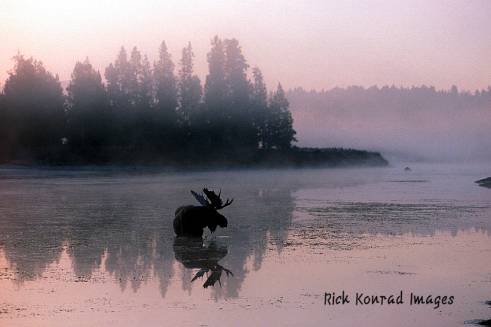
Put downloads and links to info on your smart-enough-phone
to be able to access info more easily, including webpages about the trip AND
Jackson Hole weather
http://www.mountainweather.com/JACKSON.htm
Weather map: “GeoColor is a multispectral product composed of True Color (using a simulated green component) during the daytime, and an Infrared product that uses bands 7 and 13 at night. During the day, the imagery looks approximately as it would appear when viewed with human eyes from space. At night, the blue colors represent liquid water clouds such as fog and stratus, while gray to white indicate higher ice clouds, and the city lights come from a static database that was derived from the VIIRS Day Night Band.”
https://www.star.nesdis.noaa.gov/GOES/sector_band.php?sat=G16§or=nr&band=GEOCOLOR&length=12
For the drive: Tetons area road conditions (Wyoming Department of Transportation)
http://www.wyoroad.info/pls/Browse/WRR.STATIC5?SelectedDistrict=3
A drawing of the peaks with the names of the peaks, from various locations:
https://www.nps.gov/grte/learn/management/upload/profile.jpg
___________________________________
Find a compass, altitude, latitude and longitude on your cell phone
___________________________________
An app for Grand Teton National Park info (best downloaded before you get there when you can find reliable internet), with info about visitor centers, historic places, natural features, and services throughout the park. “Even without cellular service, the app will be able to share your location on the map and bring up all site content.”
https://www.nps.gov/grte/planyourvisit/nps-grand-teton-app.htm
___________________________________
Grand Teton National Park birds has photos and details about the most common ones we can hope to see
including Bald Eagle, Red-winged Blackbird, Canada Geese, Clark’s Nutcracker, Golden Eagle, Great Blue Heron.Great Gray Owl, Harlequin duck, Loon, Magpie, Merganser, Northern Flicker (woodpecker), Osprey, Ouzel, Pelican, Peregrine Falcon, Ptarmigan, Raven, Sandhill Cranes, Steller’s Jays, Trumpeter Swan, Western Meadowlark and Western Tanager, with links to calls / songs from most of them to listen to.
and you can Download photos of over a hundred birds of Grand Teton National Park
https://www.audubon.org/climate/national-parks/grand-teton-national-park
___________________________________
You can download a free copy of these Red Cross first aid textbooks to your smart-enough-phone to bring with you (perhaps especially useful on the looooong hike many people do, and/or if you decide to backpack)
The Red Cross Wilderness and Remote First Aid Emergency Reference Guide and Red Cross Wilderness and Remote First Aid Pocket Guide
___________________________________



Lightning strikes in the last 24 hours are recorded at:
https://www.lightningmaps.org/blitzortung/america/index.php?lang=en
https://www.accuweather.com/en/us/national/severe-weather-maps
Using the lightning strikes links above you can check out where the storm lightning hits are moving
and it can help you decide if you are going to the swimming pool, taking a shower now or later, and when you actually hear thunder you can check out where it hit (closer to Yellowstone National park, miles from where we stay, or nearby at north Jackson Lake, or . . . YIPES, that really was nearby!).
___________________________________
A list of books you can download for free and read in advance of a Yellowstone or Grand Teton visit are at Recommended Reading
___________________________________
How-to-it info :
There’s easy camping info at: Have more fun camping you can learn how to build campfires that don’t smoke too much, how to pack an ice chest, do dishes in camp and lots more.
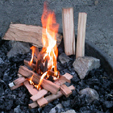
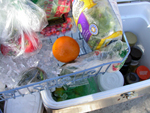
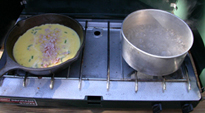


Using a campsite food storage locker, gives you ideas on how to use a metal campsite food storage locker, including some logistics on sharing one in a large group.
(If you find yourself wanting to bring more food than will fit in your campsite bear box, (with advance notice) people in a cabin might have room for your extra ice chest – but you will be responsible for refilling the ice and will not have access to it any time you want.)
There are crucial things wrong with each of these tents.
Don’t buy a cheap tent has reasons why and more examples of tents to NOT bring.

For details about our next club trip to Grand Teton National Park, go to: Grand Tetons.
Grand Tetons trip pages index has brief descriptions of most of the pages about this trip.
Grand Tetons trip transportation has flight info, driving distances and guesses at gas cost, previous trip examples, etc.
Grand Tetons trip cost has examples of
The cheap trip,
The not-so cheap trip,
The slightly more costly trip, but less driving time,
also known as the I-can’t-get-much-time-off-work trip,
and The expensive trip.
Your safety in grizzly bear territory tells you what to do if you see a bear in the distance or a bear charges you and has info about Bear Pepper Sprays
What might happen before a bison charges.
During a thunderstorm, don’t take a shower or use a sink, including washing dishes. Don’t talk on a land line phone. Don’t use your I pod. Don’t get zapped! Please read Thunderstorm and lightning safety

